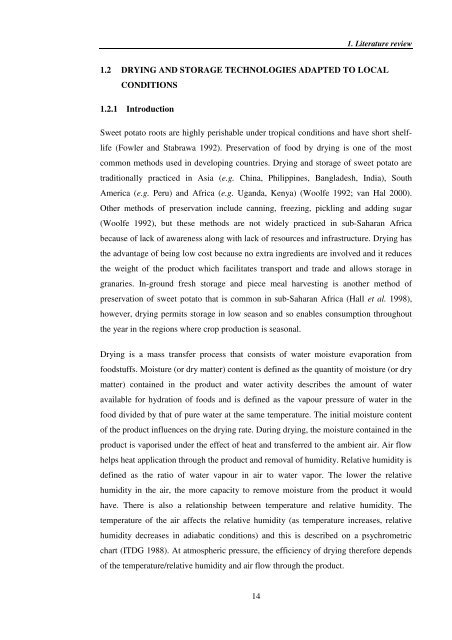Investigating carotenoid loss after drying and storage of
Investigating carotenoid loss after drying and storage of
Investigating carotenoid loss after drying and storage of
You also want an ePaper? Increase the reach of your titles
YUMPU automatically turns print PDFs into web optimized ePapers that Google loves.
14<br />
1. Literature review<br />
1.2 DRYING AND STORAGE TECHNOLOGIES ADAPTED TO LOCAL<br />
CONDITIONS<br />
1.2.1 Introduction<br />
Sweet potato roots are highly perishable under tropical conditions <strong>and</strong> have short shelf-<br />
life (Fowler <strong>and</strong> Stabrawa 1992). Preservation <strong>of</strong> food by <strong>drying</strong> is one <strong>of</strong> the most<br />
common methods used in developing countries. Drying <strong>and</strong> <strong>storage</strong> <strong>of</strong> sweet potato are<br />
traditionally practiced in Asia (e.g. China, Philippines, Bangladesh, India), South<br />
America (e.g. Peru) <strong>and</strong> Africa (e.g. Ug<strong>and</strong>a, Kenya) (Woolfe 1992; van Hal 2000).<br />
Other methods <strong>of</strong> preservation include canning, freezing, pickling <strong>and</strong> adding sugar<br />
(Woolfe 1992), but these methods are not widely practiced in sub-Saharan Africa<br />
because <strong>of</strong> lack <strong>of</strong> awareness along with lack <strong>of</strong> resources <strong>and</strong> infrastructure. Drying has<br />
the advantage <strong>of</strong> being low cost because no extra ingredients are involved <strong>and</strong> it reduces<br />
the weight <strong>of</strong> the product which facilitates transport <strong>and</strong> trade <strong>and</strong> allows <strong>storage</strong> in<br />
granaries. In-ground fresh <strong>storage</strong> <strong>and</strong> piece meal harvesting is another method <strong>of</strong><br />
preservation <strong>of</strong> sweet potato that is common in sub-Saharan Africa (Hall et al. 1998),<br />
however, <strong>drying</strong> permits <strong>storage</strong> in low season <strong>and</strong> so enables consumption throughout<br />
the year in the regions where crop production is seasonal.<br />
Drying is a mass transfer process that consists <strong>of</strong> water moisture evaporation from<br />
foodstuffs. Moisture (or dry matter) content is defined as the quantity <strong>of</strong> moisture (or dry<br />
matter) contained in the product <strong>and</strong> water activity describes the amount <strong>of</strong> water<br />
available for hydration <strong>of</strong> foods <strong>and</strong> is defined as the vapour pressure <strong>of</strong> water in the<br />
food divided by that <strong>of</strong> pure water at the same temperature. The initial moisture content<br />
<strong>of</strong> the product influences on the <strong>drying</strong> rate. During <strong>drying</strong>, the moisture contained in the<br />
product is vaporised under the effect <strong>of</strong> heat <strong>and</strong> transferred to the ambient air. Air flow<br />
helps heat application through the product <strong>and</strong> removal <strong>of</strong> humidity. Relative humidity is<br />
defined as the ratio <strong>of</strong> water vapour in air to water vapor. The lower the relative<br />
humidity in the air, the more capacity to remove moisture from the product it would<br />
have. There is also a relationship between temperature <strong>and</strong> relative humidity. The<br />
temperature <strong>of</strong> the air affects the relative humidity (as temperature increases, relative<br />
humidity decreases in adiabatic conditions) <strong>and</strong> this is described on a psychrometric<br />
chart (ITDG 1988). At atmospheric pressure, the efficiency <strong>of</strong> <strong>drying</strong> therefore depends<br />
<strong>of</strong> the temperature/relative humidity <strong>and</strong> air flow through the product.






